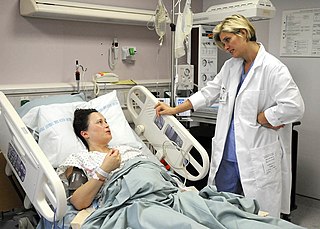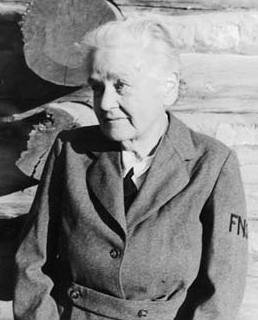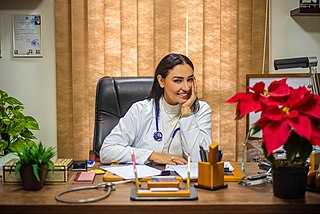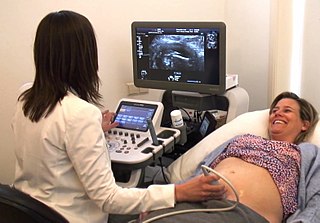
A registered nurse (RN) is a nurse who has graduated or successfully passed a nursing program from a recognized nursing school and met the requirements outlined by a country, state, province or similar government-authorized licensing body to obtain a nursing license. An RN's scope of practice is determined by legislation, and is regulated by a professional body or council.

The Australian Nursing and Midwifery Federation (ANMF) is the largest union in Australia, with 274,956 members in 2018. The union is run by nurses, midwives and assistants in nursing to advance the industrial, political and professional interests of its members.

The International Federation of Gynaecology and Obstetrics, usually just FIGO ("fee'go") as the acronym of its French name Fédération Internationale de Gynécologie et d'Obstétrique, is a worldwide non-governmental organisation representing obstetricians and gynaecologists in over one hundred territories. It was founded on 26 July 1954 in Geneva, Switzerland, to "promote the well-being of women and to raise the standard of practice in obstetrics and gynaecology". Membership is currently composed of 132 professional societies of obstetricians and gynaecologists worldwide.

In the United States, a Certified Nurse-Midwife (CNM) is a nurse midwife who exceeds the International Confederation of Midwives' essential competencies for a midwife and is also an advanced practice registered nurse, having completed registered nursing and midwifery education leading to practice as a nurse midwife and credentialing as a Certified Nurse-Midwife. CNMs provide care of women across their lifespan, including pregnancy and the postpartum period, and well woman care and birth control. Certified Nurse-Midwives are recognized by the International Confederation of Midwives as a type of midwife in the U.S.

The Frontier Nursing Service (FNS) provides healthcare services to rural, underserved populations since 1925, and educates nurse-midwives since 1939.

Mary Carson Breckinridge was an American nurse midwife and the founder of the Frontier Nursing Service (FNS), which provided comprehensive family medical care to the mountain people of rural Kentucky. FNS served remote and impoverished areas off the road and rail system but accessible by horseback. She modeled her services on European practices and sought to professionalize American nurse-midwives to practice autonomously in homes and decentralized clinics. Although Breckinridge's work demonstrated efficacy by dramatically reducing infant and maternal mortality in Appalachia, at a comparatively low cost, her model of nurse-midwifery never took root in the United States.

The presence of women in medicine, particularly in the practicing fields of surgery and as physicians, has been traced to the earliest of history. Women have historically had lower participation levels in medical fields compared to men with occupancy rates varying by race, socioeconomic status, and geography.

Nursing is a profession within the healthcare sector focused on the care of individuals, families, and communities so they may attain, maintain, or recover optimal health and quality of life. Nurses can be differentiated from other healthcare providers by their approach to patient care, training, and scope of practice. Nurses practice in many specialties with differing levels of prescription authority. Nurses comprise the largest component of most healthcare environments; but there is evidence of international shortages of qualified nurses. Nurses collaborate with other healthcare providers such as physicians, nurse practitioners, physical therapists, and psychologists. There is a distinction between nurses and nurse practitioners; in the U.S., the latter are nurses with a graduate degree in advanced practice nursing, and are permitted to prescribe medications unlike the former. They practice independently in a variety of settings in more than half of the United States. Since the postwar period, nurse education has undergone a process of diversification towards advanced and specialized credentials, and many of the traditional regulations and provider roles are changing.
Midwives in the United States assist childbearing women during pregnancy, labor and birth, and the postpartum period. Some midwives also provide primary care for women including well-woman exams, health promotion, and disease prevention, family planning options, and care for common gynecological concerns. Before the turn of the 20th century, traditional midwives were informally trained and helped deliver almost all births. Today, midwives are professionals who must undergo formal training. Midwives in the United States formed the Midwifery Education, Regulation, and Association task force to establish a framework for midwifery.

A midwife is a health professional who cares for mothers and newborns around childbirth, a specialization known as midwifery.
Angela Murdaugh is an American Catholic religious sister in the Franciscan Sisters of Mary, a Certified Nurse‐Midwife. She was a pioneer in promoting nurse midwives and birth centers. Out of this passion, she founded the Holy Family Birth Center in Weslaco, TX in 1983.

Gwendolyn Spencer, OD was a nurse and midwife, who co-founded the Jamaican Midwives' Association. An advocate for professionalism, she was instrumental in developing training programs for midwives and establishing a professional pay grade from the government for their services. She received the Order of Distinction for her contributions to healthcare in the country.

The American College of Nurse-Midwives (ACNM) is a professional association in the United States, formed in 1955, that represents certified nurse-midwives (CNMs) and certified midwives (CMs). Dating back to 1929, ACNM strives to be a leading example for excellence in midwifery education and practice in the United States and has a special interest in promoting global health in developing countries. "Members are primary care providers for women throughout the lifespan, with a special emphasis on pregnancy, childbirth, and gynecologic and reproductive health. ACNM reviews research, administers and promotes continuing education programs, and works with organizations, state and federal agencies, and members of Congress to advance the well-being of women and infants through the practice of midwifery."
Elizabeth Sager Sharp CNM, DrPH, FAAN, FACNM, was an American nurse and midwife who specialized in maternal and newborn health. In 1999, she received the American College of Nurse-Midwives' Hattie Hemschemeyer Award.
Jacqueline Dunkley-Bent OBE is England's first Chief Midwifery Officer and Professor of Midwifery at King's College London and London South Bank University.











